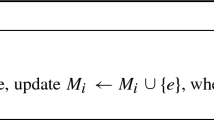Abstract
In Charikar et al. (J. Comput. Syst. Sci. 64(4):785–819, 2002) the authors proposed a new model for studying the function evaluation problem based on a variant of the classical decision tree problem for Boolean functions. In this variant each variable of the function to evaluate has an associated cost which has to be paid in order to read the value of the variable. Given a function f and an assignment σ to the variables of f, the performance of an algorithm for evaluating f is measured via the competitive ratio, i.e., the ratio of the total cost spent by the algorithm and the cost of the cheapest set of variables constituting a certificate for the value of the function on the given assignment.
In Cicalese and Laber (Proceedings of the 35th international colloquium on automata languages and programming, pp. 173–185, Springer, Berlin, 2008) a new LP based approach (the \(\mathcal{LPA}\) ) was introduced for designing competitive algorithms in the framework described by Charikar et al. The \(\mathcal{LPA}\) is based on the solution of a linear program defined on the set of certificates of the function in question. Cicalese and Laber proved that for any monotone Boolean function the \(\mathcal{LPA}\) provides algorithms with the best extremal competitive ratio (i.e., w.r.t. the worst case costs). The existence of an efficient implementation of the \(\mathcal{LPA}\) for general monotone Boolean functions remains a major open problem.
We focus on the class of threshold functions, which generalize k-out-of-n functions and have applications in several contexts. We show an interesting connection between the separating structures of threshold functions and the solution of the LP used by the \(\mathcal{LPA}.\) A direct consequence of this result is the existence of a polynomial implementation of the \(\mathcal{LPA}\) with the best competitiveness against the worst case costs for threshold functions given via a separating structure. We also show that a pseudo-polynomial implementation of the \(\mathcal {LPA}\) exists for the class of functions that are representable by read once formulas whose connectives are threshold functions given by their separating structure. In the case the threshold functions are provided via their complete DNF our algorithm runs in polynomial time.
Similar content being viewed by others
References
Anthony, M. (2001). Discrete mathematics of neural networks: selected topics. Philadelphia: Society for Industrial and Applied Mathematics.
Ball, M. O., & Provan, J. S. (1988). Disjoint products and efficient computation of reliability. Operations Research, 36(5), 703–715.
Berge, C. (1995). North-Holland Mathematical Library : Vol. 45. Hypergraphs. Amsterdam: Elsevier.
Bilbao, J. M. (2000). Cooperative games on combinatorial structures. Dordrecht: Kluwer Academic.
Boros, E., & Ünlüyurt, T. (1999). Diagnosing double regular systems. Annals of Mathematics and Artificial Intelligence, 26(1–4), 171–191.
Charikar, M., Fagin, R., Guruswami, V., Kleinberg, J. M., Raghavan, P., & Sahai, A. (2002). Query strategies for priced information. Journal of Computer and System Sciences, 64(4), 785–819.
Cicalese, F., & Laber, E. S. (2005a). A new strategy for querying priced information. In Proceedings of the 37th annual ACM symposium on theory of computing (pp. 674–683). New York: ACM.
Cicalese, F., & Laber, E. S. (2005b). An optimal algorithm for querying priced information: Monotone Boolean functions and game trees. In Lecture notes in computer science : Vol. 3669. Proceedings of the 13th annual European symposium on algorithms (pp. 664–676). Berlin: Springer.
Cicalese, F., & Laber, E. S. (2006). On the competitive ratio of evaluating priced functions. In Proceedings of the seventeenth annual ACM-SIAM symposium on discrete algorithms (SODA-06) (pp. 944–953).
Cicalese, F., & Laber, E. S. (2008). Function evaluation via linear programming in the priced information model. In Lecture notes in computer science : Vol. 5125. Proceedings of the 35th international colloquium on automata languages and programming (pp. 173–185). Berlin: Springer.
Crama, Y., & Hammer, P. (2009). Boolean functions: theory, algorithms, and applications (to appear).
Davidson, S. B., Garcia-Molina, H., & Skeen, D. (1985). Consistency in a partitioned network: a survey. ACM Computing Surveys (CSUR), 17(3), 341–370.
Garcia-Molina, H., & Barbara, D. (1985). How to assigne votes in a distributed system. Journal of the ACM, 32(4), 841–860.
Gordan, P. (1873). Über die Auflösung linearer Gleichungen mit reelen Coefficienten. Mathematische Annalen, 6, 23–28.
Grötschel, M., Lovász, L., & Schrijver, A. (1988). Geometric algorithms and combinatorial optimization. Berlin: Springer.
Heiman, R., Newman, I., & Wigderson, A. (1993). On read-once threshold formulae and their randomized decision tree complexity. Theoretical Computer Science, 107(1), 63–76.
Henderson, P. B., & Zalcstein, Y. (1977). A graph-theoretic characterization of the PV chunk class of synchronizing primitives. SIAM Journal on Computing, 6(1), 88–108.
Hu, S. T. (1968). Mathematical theory of switching circuits and automata. Berkely: University of California Press.
Karchmer, M., Linial, N., Newman, I., Saks, M., & Wigderson, A. (1993). Combinatorial characterization of read-once formulae. Discrete Mathematics, 114, 275–282.
Author information
Authors and Affiliations
Corresponding author
Additional information
This work was supported by the Sofja Kovalevskaja Award 2004 of the Alexander von Humboldt Foundation and the Bundesministerium für Bildung und Forschung.
Rights and permissions
About this article
Cite this article
Cicalese, F., Milanič, M. Competitive evaluation of threshold functions in the priced information model. Ann Oper Res 188, 111–132 (2011). https://doi.org/10.1007/s10479-009-0622-4
Received:
Accepted:
Published:
Issue Date:
DOI: https://doi.org/10.1007/s10479-009-0622-4




